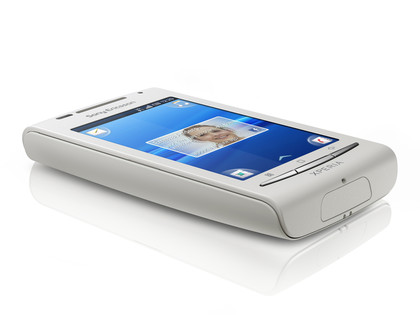Why you can trust TechRadar

Android enthusiasts won't like the fact that the Xperia X8 is based around the old Android 1.6, but for the mainstream user this won't be a problem – or even something they're aware of.
Yes, a few popular Android apps do require later versions of the OS, but 1.6 is still enough to get most jobs done, and £140 on a SIM-free basis is a good enough price for a solid phone.
Despite the small three-inch screen and low-end processor, the Xperia X8 did a good job of handling web browsing and every Android app we threw at it. Also, Sony Ericsson has created one of the few user interface skins that genuinely adds a lot of interesting features to the standard Android experience.
We liked
Sony Ericsson's user interface isn't just a few widgets and a different-looking dock – it's a total reworking of Android. The 'four corners' design makes great use of the smaller three-inch screen, and the larger widgets are easy to use. It's a bit restrictive, but will have its fans.
The fact that you get a three-inch capacitive touchscreen makes the X8 one of the better-specced Android phones at its price point, with the £140 price tag meaning you get a decent display for your money.
The battery life is good. Lay off the GPS and you'll easily get a full two days of use from the X8, while in operation the phone is fast and glitch free. Even when you've got 10 widgets stacked up on Home screens and a few apps on the go, there's no crunching. Sony Ericsson's got the X8's 600MHz processor working well.
Sign up for breaking news, reviews, opinion, top tech deals, and more.
We disliked
Sadly the X8's screen isn't very responsive. The usually reliable capacitive technology isn't working too well here, with very firm prods required to register touches. This ruins typing accuracy, making it a pain to use for messaging.
The fact that this is based around Android 1.6 means a few flagship apps are either missing or running older versions. Mainstream users won't understand why the official Twitter app isn't visible on the Android Market when using the X8, for example.
Visually, the user interface customisations look bland. It's the default Android 1.6 made blue, and that simply isn't very exciting in the face of today's sizzling smartphone competition.
The camera is a bit of a disaster and a massive step down from the one Sony Ericsson put in its own Xperia X10 Mini and X10 Mini Pro. Sure, the X8's quite a bit cheaper, but you'd be better off breaking the bank and getting an X10 Mini if you fancy using your phone for taking photos.
Verdict
The result of Sony Ericsson's Android skin is a phone that doesn't really feel like any other Android phones out there – it's more akin to using an older 'feature' phone from Sony Ericsson.
Also, there's no ignoring the recent arrival of some significantly more impressive Android phones at this cheaper end of the market. The Orange San Francisco blows the X8 away in terms of power and screen size, while somehow also managing to be cheaper. The LG Optimus One offers the modern-day thrills of Android 2.2 and a bigger screen for a similar price.
As a result, the X8 finds itself in a bit of a bad place where it's outsmarted on all fronts by other models – even Sony Ericsson's own X10 Mini is a better option. If you're not concerned about having the latest (or even a particularly recent) version of Android, the X8 will do, but it's hobbled by an unresponsive touchscreen and the many difficulties that brings.
The Sony Ericsson Xperia X8 works as a phone and is good for music and web use, but offering an out-of-date version of Android and an unresponsive screen it's best left to bargain-hunters only.
Current page: Sony Ericsson Xperia X8: Verdict
Prev Page Sony Ericsson Xperia X8: Official gallery